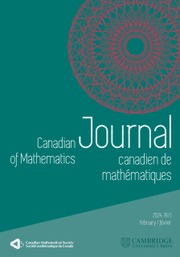No CrossRef data available.
Article contents
On a Uniqueness Theorem
Published online by Cambridge University Press: 20 November 2018
Extract
The classical uniqueness theorems of Riesz and Koebe show an important characteristic of boundary behavior of analytic functions in the unit disc. The purpose of this note is to discuss these uniqueness theorems on hyperbolic Riemann surfaces. It will be necessary to give additional hypotheses because Riemann surfaces can be very nasty. So, in this note the Wiener compactification will be used as ideal boundary of Riemann surfaces. The Theorem, Corollaries 1, 2 and 3 are of Riesz type, Riesz-Nevanlinna type, Koebe type and Koebe-Nevanlinna type respectively. Corollaries 4 and 5 are general forms of Corollaries 2 and 3 respectively.
Let f be a mapping from an open Riemann surface R into a Riemann surface R′.
Information
- Type
- Research Article
- Information
- Copyright
- Copyright © Canadian Mathematical Society 1979

